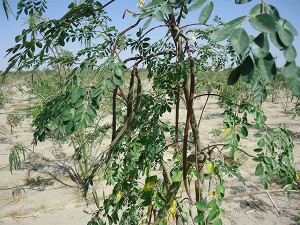 The moringa oleifera originally comes from India, where it grows in the foothills of the Himalayas. Over the centuries, the moringa has spread throughout the world’s tropical and subtropical regions. There, it is now cultivated in many countries and grown as a vegetable plant. The moringa has adapted over time to its surroundings.
The moringa oleifera originally comes from India, where it grows in the foothills of the Himalayas. Over the centuries, the moringa has spread throughout the world’s tropical and subtropical regions. There, it is now cultivated in many countries and grown as a vegetable plant. The moringa has adapted over time to its surroundings.
In its countries of origin, it has been served for thousands of years as food, medicine, and an energy source. Amazingly, all parts of the tree are usable, and the indigenous cultures of all countries where the moringa grows have independently discovered and applied its beneficial properties for people’s well-being.
 Due to its exceptional qualities, the moringa is also called the tree of life, or the miracle tree. This tree grows fast, up to three metres (almost 10 feet) per year. Its leaves and seeds are processed into food supplements.
Due to its exceptional qualities, the moringa is also called the tree of life, or the miracle tree. This tree grows fast, up to three metres (almost 10 feet) per year. Its leaves and seeds are processed into food supplements.
 Also, especially in the nutritionally-poor dry season, the leaves serve as a valuable vegetable that is rich in Vitamins A and C, calcium and iron. In addition, the seeds deliver a valuable edible oil high in unsaturated fatty acids. The seeds are also used to disinfect and purify water.
Also, especially in the nutritionally-poor dry season, the leaves serve as a valuable vegetable that is rich in Vitamins A and C, calcium and iron. In addition, the seeds deliver a valuable edible oil high in unsaturated fatty acids. The seeds are also used to disinfect and purify water.
 One litre (0.26 gallon) of contaminated water can be made safe to drink by adding 0.2 g (0.007 oz.) ground moringa seeds. The bacteria and particulate matter join to form agglomerates — previously separate components — which bind together and settle to the bottom where they can be filtered out. The tree is particularly suitable for use in projects, helping jobs and production sites created in rural areas.
One litre (0.26 gallon) of contaminated water can be made safe to drink by adding 0.2 g (0.007 oz.) ground moringa seeds. The bacteria and particulate matter join to form agglomerates — previously separate components — which bind together and settle to the bottom where they can be filtered out. The tree is particularly suitable for use in projects, helping jobs and production sites created in rural areas.
- leaves: food
- flowers: Spice, bee-keeping, medicine
- fruit: food, seed production
- seeds: food, oil, planting new trees
- bark: Medicine, making rope and paper
- roots: food, medicine
- whole plant: animal feed, biomass
- leftover “waste or trash”: improves the soil, acts as an organic fertilizer, makes great animal feed
The moringa brings many blessings not only for humans, but also for plants and animals. Due to this tree’s high content in proteins, vitamins, minerals and amino acids, animals who eat moringa in their feed as a supplement grow healthier and have increased resistance to disease and stressful situations. Even plants that are sprayed with a plant fertilizer produced from the moringa show an increase in earnings of up to 32%. This increase in revenue is due to two plant growth hormones found in the moringa.
The Moringa, a Powerhouse
 Its leaves could protect millions of lives. The moringa tree is indeed one of the
Its leaves could protect millions of lives. The moringa tree is indeed one of the  most nutritious plants in the world. The protein content in dried leaves — calculated based on 100 g — (3.5 oz.) is four times greater than that of eggs and contains or exceeds all of the essential amino acids. In fact, moringa leaves contain seven times more Vitamin C than oranges, more Vitamin A than carrots, as much Vitamin B as liver, more iron than spinach, more calcium than milk and more potassium than bananas.
most nutritious plants in the world. The protein content in dried leaves — calculated based on 100 g — (3.5 oz.) is four times greater than that of eggs and contains or exceeds all of the essential amino acids. In fact, moringa leaves contain seven times more Vitamin C than oranges, more Vitamin A than carrots, as much Vitamin B as liver, more iron than spinach, more calcium than milk and more potassium than bananas.




